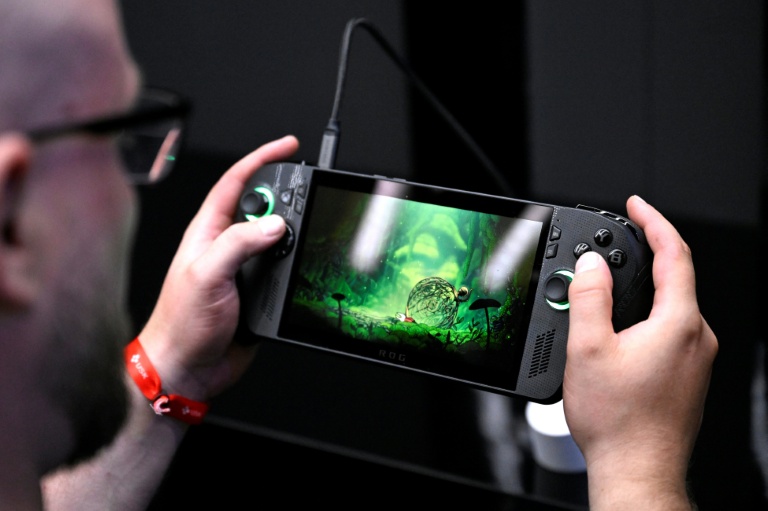Business
Microsoft Launches Xbox ROG Ally to Compete with Nintendo Switch

The gaming landscape is set for a new showdown as Microsoft re-enters the handheld gaming market with its Xbox ROG Ally. This announcement coincides with the record launch of the Nintendo Switch 2, which sold 5.8 million units within seven weeks of its release. The Xbox ROG Ally, designed for both home and portable play, will be showcased at the Gamescom trade show in Cologne, Germany, where attendees can experience the device firsthand. Microsoft plans to launch the console on October 16, 2023, though the pricing details remain undisclosed.
The Xbox ROG Ally is the result of a collaboration with Taiwanese hardware manufacturer Asus. The device features a central screen flanked by grips that include the familiar array of joysticks, triggers, and buttons synonymous with traditional Xbox controllers. According to Jason Ronald, Microsoft’s Vice President of Console Development, the company aims to create a comprehensive ecosystem that allows gamers to enjoy their favorite titles wherever they are.
With Microsoft facing declining console sales and a Game Pass subscription service that has not yet captured a significant player base, the company seeks to diversify its offerings. The handheld market presents an opportunity for growth, particularly as it aims to engage current Xbox owners and PC gamers.
Competing for Market Share
The launch of the Switch 2 has set a high bar for competitors. According to Rhys Elliott of Alinea Analytics, the Switch 2’s unique library of exclusive games, such as those from the Mario and Zelda franchises, has solidified its fan base. In contrast, Valve, another American competitor, has made significant strides with its Steam Deck, which has sold several million units since its release in 2022. The Steam Deck and Xbox ROG Ally target a similar market segment, appealing to gamers looking for portable alternatives to powerful gaming PCs.
Christopher Dring, founder of The Game Business, emphasizes that Microsoft’s strategy focuses on enhancing player engagement. By encouraging users to play more frequently, especially when away from their home consoles, Microsoft hopes to increase overall spending on games. This strategy reflects a broader industry trend where portable devices are viewed as complementary to existing consoles.
Sony’s Cautious Approach
While Microsoft and Valve are actively pursuing the handheld market, Sony has taken a more cautious approach. The company previously exited the portable gaming scene following the underperformance of the PlayStation Vita in 2011. The original PlayStation Portable sold approximately 76 million units since its launch in 2004, but Sony has not disclosed sales figures for the Vita.
In late 2023, Sony re-entered the conversation with the introduction of the PlayStation Portal, a device that allows users to stream games from their home console. Industry estimates suggest sales of around two million units for the PlayStation Portal, but analysts note that remote play currently appeals to a limited audience. Mat Piscatella of Circana highlights the potential for growth in this area, indicating that while remote play impacts a small portion of the gaming community, its popularity is steadily increasing.
As the competition heats up in the handheld gaming market, the dynamics between these major players will shape the future of gaming. With both Microsoft and Valve actively engaging in this sector, and Sony cautiously exploring its options, the race for dominance in portable gaming is poised to intensify.
-

 Politics4 weeks ago
Politics4 weeks agoSecwepemc First Nation Seeks Aboriginal Title Over Kamloops Area
-

 World5 months ago
World5 months agoScientists Unearth Ancient Antarctic Ice to Unlock Climate Secrets
-

 Entertainment5 months ago
Entertainment5 months agoTrump and McCormick to Announce $70 Billion Energy Investments
-

 Science5 months ago
Science5 months agoFour Astronauts Return to Earth After International Space Station Mission
-

 Lifestyle5 months ago
Lifestyle5 months agoTransLink Launches Food Truck Program to Boost Revenue in Vancouver
-

 Technology3 months ago
Technology3 months agoApple Notes Enhances Functionality with Markdown Support in macOS 26
-

 Lifestyle3 months ago
Lifestyle3 months agoManitoba’s Burger Champion Shines Again Amid Dining Innovations
-

 Top Stories2 months ago
Top Stories2 months agoUrgent Update: Fatal Crash on Highway 99 Claims Life of Pitt Meadows Man
-

 Politics4 months ago
Politics4 months agoUkrainian Tennis Star Elina Svitolina Faces Death Threats Online
-

 Sports5 months ago
Sports5 months agoSearch Underway for Missing Hunter Amid Hokkaido Bear Emergency
-

 Politics5 months ago
Politics5 months agoCarney Engages First Nations Leaders at Development Law Summit
-

 Technology5 months ago
Technology5 months agoFrosthaven Launches Early Access on July 31, 2025





















